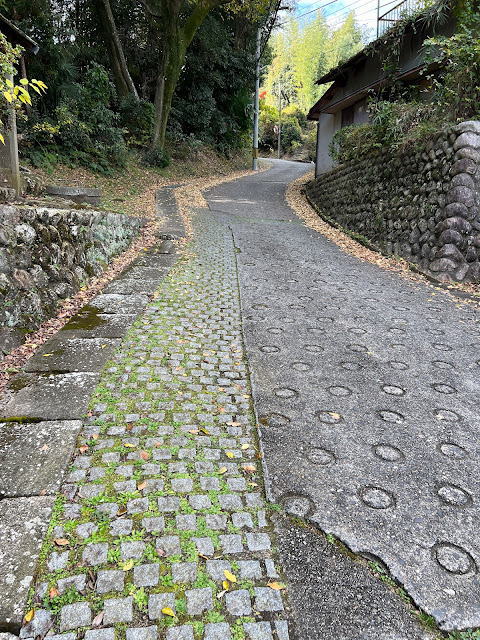Needing to take three trains to get back to Utsube from my hotel, the day began with a shemozzle when the ticket barriers wouldn’t let me use the IC card (stored value card) on my phone to connect to a non-JR line at Nagoya station. I showed it to the station attendant, who said many things only one of which I understood: “JR”, accompanied by a point in the direction whence I’d come. I took a guess that the problem was I’d used the IC card to board a JR train at some point but hadn’t used it to pass ‘out’ through the barriers at the other end (big Japanese stations and inter-line connections can be very confusing for the novice).
So I hopped on a JR train one stop back to Kanayama using my JR pass, went out through the barriers using the IC card (that worked ok) and then immediately turned around and used the JR pass to travel back to Nagoya and try the troublesome transfer again. This time, all went smoothly.
Not only has that long-winded explanation lost the few readers this blog has; all the faffing around also cost me about half an hour in travel time, so it was well after 8am that I finally set off walking from Utsube. At least I’d had another ride on the lovely little Utsube Line to get me there:
Soon after leaving Utsube I crossed a river, then Route 1, and found myself in quiet back streets where the road climbed one of the most significant hills I’d encountered for many days.
From the top, views looked back over the town of Yokkaichi and, somewhere beyond, Nagoya.
Unfortunately, the top of the hill also meant rejoining Route 1. A little way along the ridge, a konbini came into view, and I stopped for one of their surprisingly good automatic-machine coffees. Unlike many konbini, this one had a proper seating area inside.
Back on the road, I was overtaken by a man in hiking gear striding purposefully in the same direction. “Tokaido?” he asked. Yes, I replied, and as usual apologised for my lack of Japanese. Fortunately he spoke very good English, and we started swapping stories about where we’d come from, where we were heading today and when we hoped to reach Kyoto.
Jun-San was an excellent walking companion. He asked about Australia and told me about his life in Kumamoto on the southern island of Kyushu (I hope I’ve got the location right – I really should have asked him to write it down for me), where he has retired to look after his family’s small farm and – obviously – walk the Tokaido. We spoke mostly in English, but he encouraged me to speak Japanese and was generous enough to put up with my halting attempts and patient enough to gently correct my worst errors.
Generally, we were too busy chatting to take many photos, but we stopped by this huge and largely leafless tree on an ichirizuka:
It turned out we both planned to get to Seki today, although Jun-San had a hotel booked in nearby Kameyama whereas I had to make the much longer trip all the way back to Kanayama (I kept getting the names confused) via Nagoya.
Nearing Seki, an avenue of stone lanterns led to a shrine illuminated by a burst of late-afternoon sun…
… and, just beyond, maples that seemed to be on fire:
The town of Seki itself is one of the best-preserved Edo-period streetscapes I’ve seen:
… although I’m not sure having me in the photo does much to enhance the scenery:
From there, it was just five minutes down the hill to the little station (happily for me, on a JR line, so I could use my pass), and a fifteen-minute wait for a train to Kameyama, where Jun-San would disembark for his hotel and I would change for Nagoya.
The train, when it did arrive, was if anything even cuter than the Utsube line rolling stock: a brightly painted single carriage with colourful curtains reminiscent of your nan’s living room.
Again, Jun-San insisted on taking a photo with me in front of the main attraction:
At Kameyama we said farewell, with many thanks for fine company along the road and best wishes for a successful last few days on the Tokaido. Jun-San, if you’re ever able to get to Australia to see those wild kangaroos you want to encounter, contact me so I can show you some of the sights of Sydney.
It was great walking with you today! Ganbatte!













Comments
Post a Comment